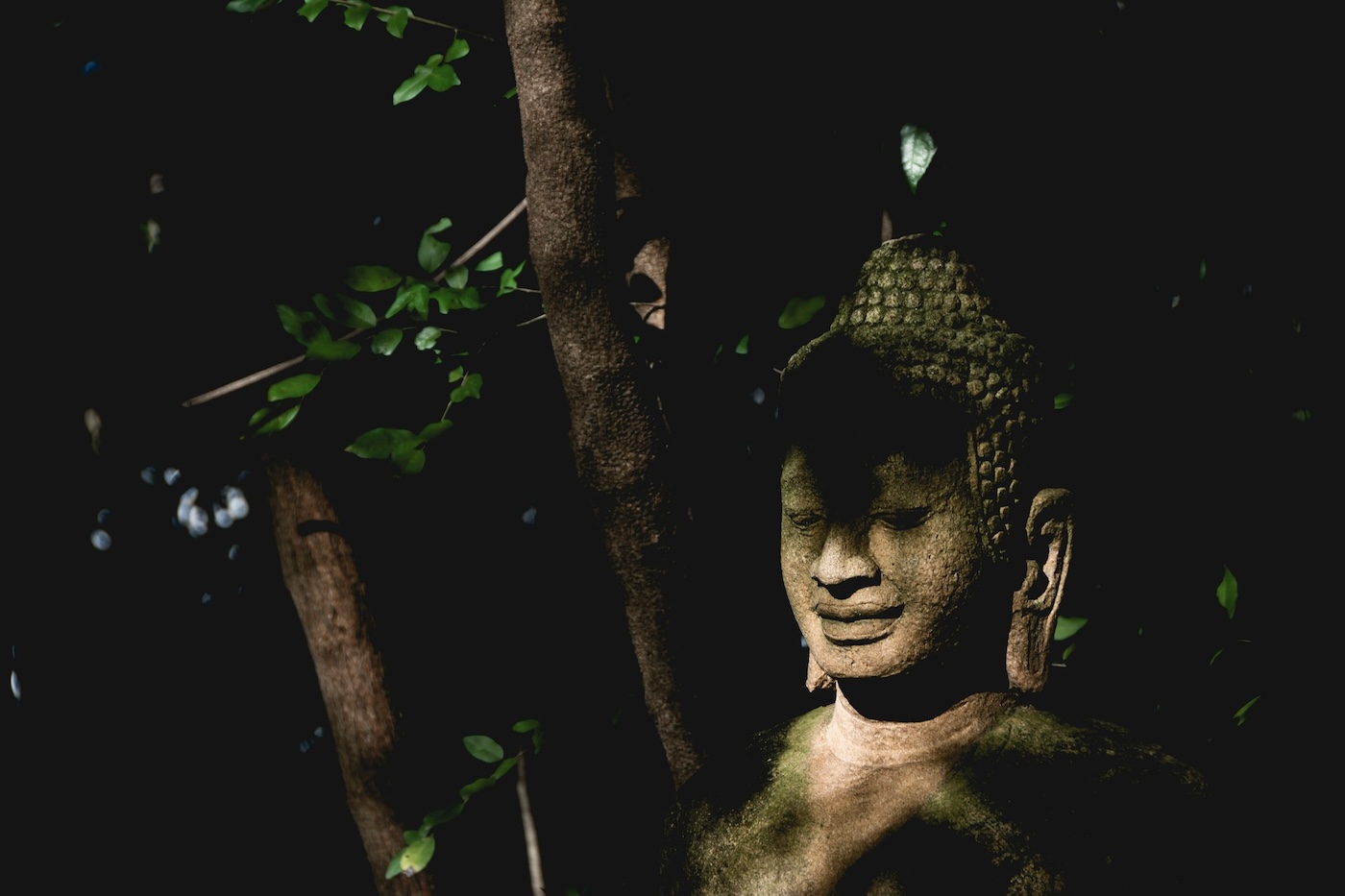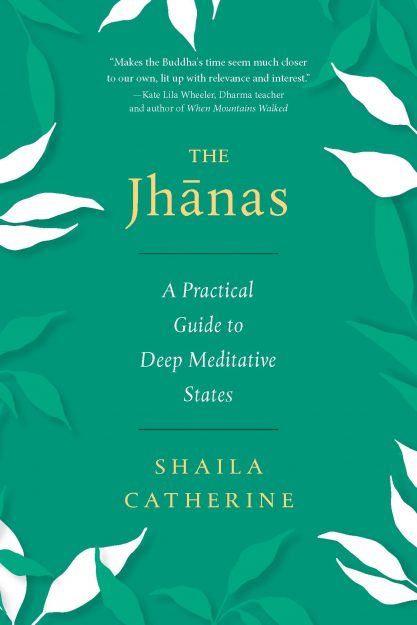Access to Absorption
A Theravada teacher on achieving the prerequisite mentals state for deeper meditation. The post Access to Absorption appeared first on Tricycle: The Buddhist Review.

One who, whether walking, standing, sitting, or lying down, has calmed his thoughts and delights in the stilling of thought: a bhikkhu such as this can reach the highest enlightenment. —Anguttara Nikaya 4:11
The first formal instruction I received for jhāna practice surprised me. My teacher told me to meditate in any way that supported the development of three qualities: mental brightness, spaciousness, and relaxation. I had expected the early instructions to emphasize vigorous focus on a narrow object. It soon became clear, however, that demanding effort can create tension; in the wake of tension, aversion and hindrances thrive. Conversely, a relaxed, bright, and spacious mind contributes to mental and physical ease and encourages a natural awareness of present-moment experience.
For concentration to deepen, the mind needs to relax. It cannot stay on the defensive. A mind that is glad is easily concentrated. In spiritual life gladness is not the giddy excitement expressed by titillation or thrill. The deeper forms of gladness arise when you trust your virtue. Happiness arises when you can trust the purity of your own heart’s intentions. In short, it is a happiness of non-remorse.
It is through sincere reflection and our inner ethical commitments that we purify our intentions and grow to trust ourselves. If our ethical foundation is uncertain, tranquility will remain shaky, and the mind will be unable to confidently settle into this living process of purification.
We can improve the texture of the mind by influencing the kind of thoughts we tend to think. When you observe thoughts that diminish the qualities you appreciate, abandon those thoughts and give a thought or two to something virtuous, respectable, joyful— perhaps a thought of kindness.
Basic Instructions for Stabilizing the Mind
The Buddhist tradition suggests a number of objects for jhāna meditation, including colors, light, the basic elements (earth, fire, water, and wind), foul aspects of bodily experience, or beautiful inner qualities such as loving-kindness, compassion, joy, and equanimity. Each object has the potential to raise the mind to correspondingly distinct levels of absorption. Traditionally, an experienced teacher tailors the meditation subject according to the student’s disposition, meditative ability, interest, and intention.
The breath serves as a powerful, and popular, meditation subject. It can bring the mind through the four jhāna states. It is the preferred meditation subject for many practitioners. Although certain individuals might find jhāna easier to attain with a different meditation subject, the skills developed working with the breath can be applied to any meditative endeavor.
In the Buddhist tradition, the designation of a state called access concentration arose as a convenient term to describe the conditions that immediately precede jhāna. Although there is no direct reference in the discourses of the Buddha to access concentration as a distinct state, the conditions that lead to jhāna are clearly described—and when these conditions arise, access to jhāna is possible.
***
Once you are sitting in a comfortable and alert posture, incline your mind toward qualities of brightness, spaciousness, and relaxation. You will experience a joyful sense of balance when your effort is diligent and relaxed. Allow the quality of your mind to be spacious and unconstricted, even while you are focused on a precise perception. Encourage an uplifting sense of mental brightness to support alertness, clarity, joy, perkiness, and enthusiasm for developing concentration and insight. Then, apply focused attention to experience the initial sensations of the breath touching the nostrils or upper lip. Direct your attention to the breath at the nostrils or upper lip area. The actual location will vary from person to person, depending on the angle of the nose, structure of the jaw, shape of the lips, and facial features; there is no best or correct place. Feel where the breath naturally touches you. Whenever the attention drifts off that point of sensation, guide it back, simply and diligently. Each time the awareness wanders off with thoughts of the past or the future, simply drop this preoccupation with thoughts by reaffirming the directed focus of your activity. Ignore everything else: environmental sounds, pain, thoughts, or plans. If emotions, great insights, a review of yesterday’s shopping list, a plan for redecorating your kitchen, a replay of a movie you recently watched, or any profound or mundane thought should arise, invest no interest in these events and guide the attention back to the breath.
Although this instruction is simple to understand, within just a few minutes of practice you will notice that the mind tends to wander away from that point of contact where the breath is felt. It may wander through past thoughts, future plans, or a commentary on the present experience of sitting and feeling the breath at your nose. Whatever thoughts arise, interesting or boring, supportive or destructive of your self-esteem, let them all go unequivocally. The discipline here is to discard all entanglement without judging yourself and return happily to the meditation subject, with a spacious, bright, and relaxed mind.
Let sounds, sensations, and thoughts go their own way; there is no need to follow them. You may initially notice a multitude of perceptions: sounds might impinge, pain might be felt, thoughts might meander through consciousness. These are all normal sensory experiences. You don’t need to push them away, but you don’t need to maintain interest in them either. Keep sequestering the mind close to the breath, abandoning the urge to move toward the various sensory experiences that will inevitably arise. This streamlined practice, sustained over time, creates a powerful momentum of concentration by connecting and sustaining the attention on a chosen object.
Initially, the breath may appear with distinct physical properties: vibration, temperature, tension, pressure, and roughness, for instance. To develop concentration, remain steadily aware of the breath by connecting and sustaining attention with the breath, but without emphasizing the physicality of changing sensations. As the attention remains connected for longer periods of time without distraction, there will be a corresponding withdrawal of awareness from bodily sensations. Awareness of distinct sensations related to the sitting posture will diminish. Awareness of room temperature will fade. Sounds might occur as remote innocuous notes without pulling the attention toward them. Aches, pain, tensions, or twinges in the body will hardly be noticed. Gradually, even the sensations associated with the breath will fade and disappear. Parallel to this growing separation from physical sensory experiences, pleasant mental qualities of bliss, lightness, delight, rapture, pleasure, and happiness will grow, supporting the sustained connection. You will gradually experience clear awareness—samādhi is not a dull or drifting state—yet the objects you perceive will not be bound to the gross field of sensory perception.
As we’ve noted, meditation requires diligent effort and clear intention. You cannot demand that distractions vanish, but you can cultivate a deep willingness to repeatedly and happily let go. If you try to adhere to the breath and wrestle violently with anything that threatens that hold, you will quickly become tense and probably decide to quit before you have barely begun. But if you allow yourself to enjoy letting go of distractions, to feel happy to reconnect, and to meditate unburdened by pressure to accomplish a certain number of consecutive breaths, happiness will arise through the simple joy of relinquishment.
When attention is continuously applied, intrusive thoughts subside. If a thought should arise, there will be no fuel for proliferation.
It is just a tiny transparent thought that wisps through the mind without causing disturbance, like a momentary bubble on a stream or an ephemeral cloud in the sky. The few thoughts that do arise are entirely wholesome and often concern the meditation practice. Alertness thrives; the mind brightens. When access to jhāna is available, there are no hindrances in the mind: no craving, no judging, no doubt, no agitation, no greed. The pulsing activities of vitakka and vicāra continue. Relaxed, bright, and spacious, with a momentum of concentration supporting the process, the mind coheres around its object.
With the absence of hindrances, in the presence of joy, happiness, tranquility, and concentration, there is a feeling of great relief.
The Counterpart Sign
At some point, you will stop feeling tangible qualities of the breath. The mind will become collected through the repeated directing and sustaining of attention on a subtle knowing of breath, rather than on perceptions of tangible qualities such as temperature, movement, or pressure. Continue to focus the attention in the area of the nostrils or upper lip. You may perceive a subtle feeling of contact with breath or settle the attention in the space just off the body near the location where breath occurs. Stay focused on the whole breath—from the very start of the inhalation through to the end of the exhalation—without attention wavering. Be attentive to a continuous perception of breath as the object, rather than particular sensations associated with the breath.
The deepening of samādhi involves this distinctive shift from the physicality of breath sensations as the object of concentration to what is called the counterpart sign or nimitta. The nimitta may initially appear as a vibrating pearly bright light that occurs in conjunction with the in- and out-breath, or a soft luminous perception likened to cotton wool. Please don’t jump to the conclusion that the first appearance of light in the mind is your counterpart sign. The mind progressively brightens long before the breath nimitta appears. Many meditators stall their progress by following after “false nimittas”—changing colors, changing images, flashes, motley fields of light, or visual impressions of light that remove the focus of attention from the breath-point to another location (most commonly above the eyes or in the head).
The breath nimitta usually appears as a stable, smooth, white radiance associated with the focus on the breath. It is a mental reflection of the breath and does not include physical sensations. The impression of inner light and the orientation to the breath may appear to have merged into a single mental experience. The breath nimitta arises as a result of the concentration and serves as the first landmark of a state conducive to absorption. By learning to notice when this sign arises, you will be able to retrace your steps in the future and attain jhāna when desired.
A skilled meditator should have the capacity to direct the attention at any time, either back to the physicality of the sensation of breath or to the mental experience of the counterpart sign. To confirm that you do have the option, it is helpful to sometimes choose the physicality and sometimes shift to the counterpart sign. If you decide to remain attentive to physical sensations, rapture will still arise, but it will be known as physical delight. If you accept the subtler luminous mental sign as the object for concentration, this shift to the subtler mental perception can lead to absorption. To attain access to jhāna, you would choose the perception of pleasant, radiant light as the new nimitta and allow the attention to remain steadily focused on this luminous perception.
Discerning the nimitta is the first step in stabilizing this refined mental object for concentration. To deepen samādhi, you will give no further attention to physical sensations of breath. Your meditation object has become the nimitta, the counterpart sign. It is known as a stable, luminous mental focus without sensation.
The momentum of samādhi naturally inclines toward the subtler experience of mental brightness, but skillfulness always includes options. Concentration can be very strong. The mind should never be propelled through this system nor sucked into a vortex of concentrated energies. Wise practitioners will moderate the pace and fully develop their meditative skills before moving to the next stage. By valuing both the release into a profound depth of experience and the insight that arises with dynamic proximity to the senses, you can explore the intertwined trainings of concentration and insight— simultaneously exploring how attention connects with both physical and mental objects of perception.
Access to Jhāna
How strong does concentration need to be to be sure access is attained? Access to jhāna has been achieved when there is a sustained experience of a unified mind free of all hindrances and imbued with strong factors of vitakka, vicāra, pīti, sukha, and ekaggatā. Attention, undistracted by thoughts or sensory perceptions, remains intensely focused on the nimitta. The mind is utterly bright, the heart relaxed.
Fundamentally, access concentration describes an absence of hindrances conjoined with the presence of strongly developed jhāna factors. These conditions are recognized prerequisites to jhāna, as the Buddha describes:
And when he knows that these five hindrances have left him, gladness arises in him, from gladness comes delight, from delight in his mind his body is tranquilized, with a tranquil body he feels joy, and with joy his mind is concentrated. Being thus detached from sense-desires, detached from unwholesome states he enters and remains in the first jhāna.
With the absence of hindrances, in the presence of joy, happiness, tranquility, and concentration, there is a feeling of great relief. The feeling of relief characterizing access to jhāna increases to a sense of safety with the arising of jhāna: safe from distraction, safe from hindrances, or, as the ancient scriptures describe, removed from the forces of Māra.
The jhāna factors of connecting, sustaining, joy, pleasure, and one-pointedness will continue to strengthen. If your energy drops, you may find sounds or sensations intruding on the meditation. Gentle, joyful persistence is essential. If the mind becomes distracted, simply let the distracting perception be, and reconnect with the nimitta. Nurture equanimity; be happy to connect with the whole breath or the light nimitta; direct your attention to whichever object is apparent there. Reconnect repeatedly, clearly aware of gladness infusing the connection. Keep lifting the mind up to its object. Use this power of vitakka to refresh the connection whenever the energy sinks or the attention scatters.
Consider whether true happiness can ever be found through sensory experiences. Once you achieve the certainty that happiness will not be found by getting more sensory pleasures or thinking more interesting thoughts, your commitment to inner exploration will deepen.
When the prerequisites to jhāna are stable and sustained, focus the attention for just a moment on the distinctive absence of hindrances. Consider whether true happiness can ever be found through sensory experiences. Once you achieve the certainty that happiness will not be found by getting more sensory pleasures or thinking more interesting thoughts, your commitment to inner exploration will deepen. Recognize that this variety of seclusion is a source of joy and relief. After reflecting in this way, continue to develop the basic practice of connecting and sustaining attention on the light that infuses the breath perception.
Let go with relief and allow the withdrawal from thoughts, personal concerns, and sensations to continue, unforced and unbroken. Mental brightness will continue to increase. A sense of cohesion and mental unification will grow. Since at this stage concentration is still fragile, this deep release is often interrupted by distraction. Quickly but gently enhance your energetic interest and strengthen the connecting and sustaining activity.
With this practice, the mind is preparing itself for the altered state of jhāna—a deeply absorbed state of mind that can retain its unity without effortful striving. When vitakka and vicāra are strong and infused with delight, you won’t need to continually refresh the connection or fuss with the energy. It is natural for the mind to stay attentive to that which is delightful. So harness this power of happiness and let it totally permeate the nimitta, allowing the mind to become increasingly stable, cohesive, and bright.
These references to delight, gladness, happiness, and rapture could cause you to expect dramatic ecstatic pleasures. The process is more subtle than that. A unified mind experiences such refined pleasures that, although the quiet presence of sublime happiness permeates consciousness and accompanies each stage of jhāna, the jhāna factors will barely be noticed while in jhāna. They are discerned primarily in the moments prior to absorption and upon emerging from jhāna.
Are there thoughts and hindrances that you can set aside, or is there an absence of hindrances in the mind? When you perceive the genuine absence of hindrances, you will feel happy: the happiness I’ve described as a great relief. Become sensitive to the subtle pleasant quality of rapture when connecting with the nimitta. When attention is quiet and steady, pīti does not have to be gloriously exciting. You will need only just enough joy to keep your interest in the breath or breath nimitta fresh. Enjoy the ease of a mind that is growing in purity and stability.
 Photo by Wisdom Publications
Photo by Wisdom Publications♦
This article was excerpted from The Jhanas: A Practical Guide to Deep Meditative States by Shaila Catherine, © 2024 Shaila Catherine. Reprinted in arrangement with Wisdom Publications.

 Lynk
Lynk 



















.jpg&h=630&w=1200&q=100&v=6e07dc5773&c=1)



.jpg&h=630&w=1200&q=100&v=6e07dc5773&c=1)






